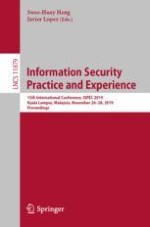2019 | Book
Information Security Practice and Experience
15th International Conference, ISPEC 2019, Kuala Lumpur, Malaysia, November 26–28, 2019, Proceedings
Editors: Swee-Huay Heng, Javier Lopez
Publisher: Springer International Publishing
Book Series : Lecture Notes in Computer Science
